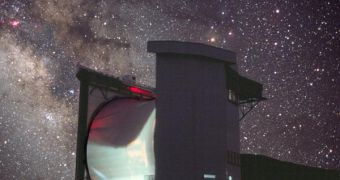All known spiral galaxies have supermassive black holes at their center and our Milky Way is no different. However, observing a black hole is rather a difficult task, especially when it is situated in regions of space populated by large amounts of matter such as those in the galactic nuclei of active galaxies. The best observation ever of the Milky Way's black hole was conducted by observing the effects produced on the material 100 million kilometers close to the center of the galaxy.
Recently, a team of astronomers from the U.S., using an array of three radio telescopes scattered throughout the territory of the country succeeded in detecting radio emissions coming from the vicinity of the black hole, with a resolution three time higher than the previous. The black hole object in the center of our galaxy, dubbed SgrA*, similarly to the other central galactic black holes, is surrounded by a large accretion disk of matter spinning around it. As the material is being drawn towards the singularity by the object's massive gravitational field, it heats up to temperatures high enough to emit light in multiple wavelengths, such as optical, X-ray, infrared and others.
The detection made in the month of April last year was performed according to a basic interferometry method, by conducting simultaneous observations of the same general region of space, with telescopes situated more than 4500 kilometers apart. As light is emitted from the massive accretion disk around the black hole, it will be ultimately absorbed by the mass of gas present throughout the interstellar space, and re-emitted in the form of radio waves with wavelengths of about 1.3 millimeters.
Taking into consideration that a large amount of the molecular hydrogen gas inside our galaxy has already been processed to create objects such as stars, the radio emission would most likely come from the matter eliminated during the supernova phase, in the form of hot gas. So far, it is not clear how much of the matter in the accretion disk is really being sucked beyond the black hole's event horizon and how much is being thrown back into space by the intense heat and the powerful magnetic fields of the black hole.
The fact is there is no proof whatsoever that the supermassive object in the center of our galaxy is even a black hole, but future observations should provide with increased resolution images of the respective area to create a better picture of the processes which take place in the respective area of space. By the year 2010, the Large Millimeter Array in Chile will become operational, thus enabling observations in even shorter wavelengths.
The Theory of General Relativity predicts that the massive amount of matter contained in the black hole would generate a gravitational field powerful enough to bend the space-time fabric. Proving that a black hole is situated in the galactic nucleus should be just matter of observing the effects produced by such massive gravitational fields.
Sheperd Doeleman from MIT's Haystack Observatory argues that the accretion disk spinning on top of the event horizon would have a doughnut shape, but it does not deny there might be a possibility that, in fact, the black hole is surrounded by a spheroidal cloud of matter. Although there is basically low chance that the event horizon will be actually seen, the spheroidal matter distribution should enable a rough description through the gravitational effects exerted by the black hole.

 14 DAY TRIAL //
14 DAY TRIAL //